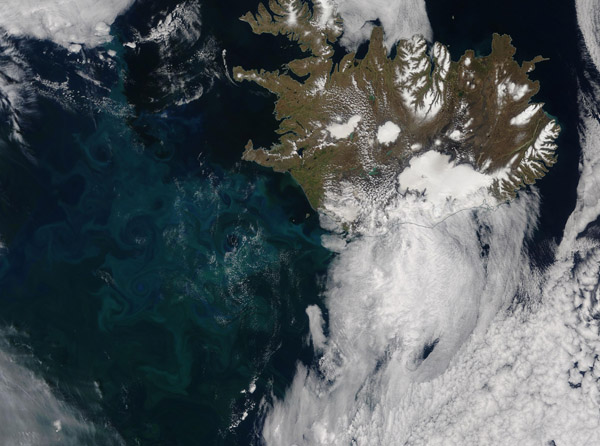Images
June 17, 2019 - Phytoplankton Bloom off Iceland
Tweet
Swirls of blues and greens filled the North Atlantic Ocean west of Iceland in mid-June 2019. The Moderate Resolution Imaging Spectroradiometer (MODIS) on board NASA’s Terra satellite acquired a true-color image of a fabulous spring phytoplankton bloom on June 10.
The swirls of turquoise, greens, and chalky blues are created by massive numbers of tiny, plant-like organisms known as phytoplankton. Phytoplankton contain pigments and chlorophyll and, when abundant, the colors within each organism blend with many millions of others to create large, bright blooms which can easily be seen from space.
Phytoplankton live year-round in the oceans, but most of the year they exist in small numbers and are dispersed in ocean layers by vertical mixing, which is most intense in winter time in this region. When conditions are right, they begin to reproduce exponentially, creating extremely large populations known as “blooms”. Phytoplankton blooms in the North Atlantic Ocean occur in the spring and in the fall. The spring bloom is driven by many factors, including lengthening daylight, increasing water temperatures in the upper layers of water, and the right type and amount of nutrients.
Image Facts
Satellite:
Terra
Date Acquired: 6/10/2019
Resolutions:
1km (184.6 KB), 500m (487.2 KB), 250m (1.4 MB)
Bands Used: 1,4,3
Image Credit:
MODIS Land Rapid Response Team, NASA GSFC
Tweet
Swirls of blues and greens filled the North Atlantic Ocean west of Iceland in mid-June 2019. The Moderate Resolution Imaging Spectroradiometer (MODIS) on board NASA’s Terra satellite acquired a true-color image of a fabulous spring phytoplankton bloom on June 10.
The swirls of turquoise, greens, and chalky blues are created by massive numbers of tiny, plant-like organisms known as phytoplankton. Phytoplankton contain pigments and chlorophyll and, when abundant, the colors within each organism blend with many millions of others to create large, bright blooms which can easily be seen from space.
Phytoplankton live year-round in the oceans, but most of the year they exist in small numbers and are dispersed in ocean layers by vertical mixing, which is most intense in winter time in this region. When conditions are right, they begin to reproduce exponentially, creating extremely large populations known as “blooms”. Phytoplankton blooms in the North Atlantic Ocean occur in the spring and in the fall. The spring bloom is driven by many factors, including lengthening daylight, increasing water temperatures in the upper layers of water, and the right type and amount of nutrients.
Image Facts
Satellite:
Terra
Date Acquired: 6/10/2019
Resolutions:
1km (184.6 KB), 500m (487.2 KB), 250m (1.4 MB)
Bands Used: 1,4,3
Image Credit:
MODIS Land Rapid Response Team, NASA GSFC




